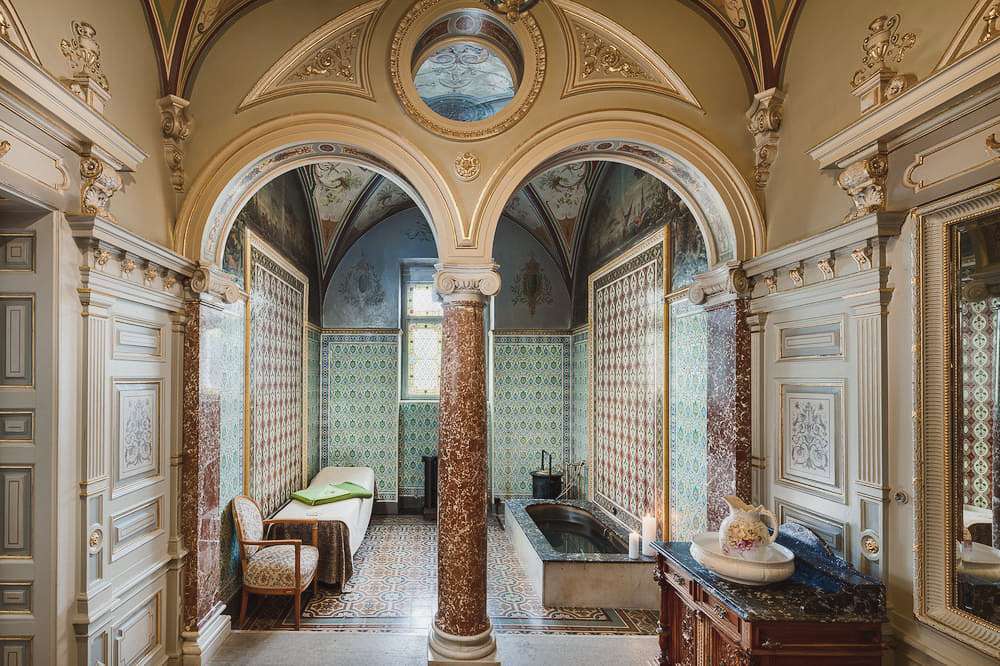In its list of new World Heritage Sites, UNESCO has recognized Europe’s longstanding wellness culture.
Eleven towns across seven European countries are now World Heritage Sites, selected for elevating Europe’s “spa culture” that emerged in the 18th century.
“The Great Spa Towns of Europe” are located across Austria, Belgium, Czechia, France, Germany, Italy, and the UK.
“All of these towns developed around natural mineral water springs,” reads the induction on the UNESCO World Heritage web page. “They bear witness to the international European spa culture that developed from the early 18th century to the 1930s, leading to the emergence of grand international resorts that impacted urban typology around ensembles of spa buildings such as the kurhaus and kursaal (buildings and rooms dedicated to therapy), pump rooms, drinking halls, colonnades and galleries designed to harness the natural mineral water resources and to allow their practical use for bathing and drinking. Related facilities include gardens, assembly rooms, casinos, theatres, hotels and villas, as well as spa-specific support infrastructure.”
According to UNESCO, the towns are all integrated into an “overall urban context” that includes a “carefully managed recreational and therapeutic environment in a picturesque landscape. Together, these sites embody the significant interchange of human values and developments in medicine, science and balneology.”
UNESCO World Heritage Sites
UNESCO has been selecting World Heritage Sites since 1978, recognizing the “outstanding universal value” as a means of awareness and preservation of areas that face risks from neglect, climate change and overdevelopment. It now boasts more than a thousand sites spanning the cultural and natural. The Galápagos Islands were the organization’s first recognized site.
Among the natural sites included this year is Thailand’s Kaeng Krachan forest, Georgia’s Colchic Rainforests and Wetlands, and South Korea’s Tidal Flats—one of the world’s most important locations for migratory bird populations. The World Heritage Designation can make regions eligible for certain funds and resources aimed at continued site preservation.
Voting was postponed last year due to COVID. This year’s selections feature 33 locations, including those listed for 2020.
2020
- Turkey: Arslantepe Mound
- Peru: Chankillo Archaeoastronomical Complex
- Belgium/Netherlands: Colonies of Benevolence
- France: Cordouan LighthouseIndia: Kakatiya Rudreshwara (Ramappa) Temple, Telangana
- Germany: Mathildenhöhe Darmstadt
- Italy: Padua’s fourteenth-century fresco cycles
- Spain: Paseo del Prado and Buen Retiro, a landscape of Arts and Sciences
- China: Quanzhou: Emporium of the World in Song-Yuan China
- Romania: Roșia Montană Mining Landscape
- Brazil: Sítio Roberto Burle Marx
- Austria, Belgium, Czechia, France, Germany, Italy, United Kingdom of Great Britain and Northern Ireland: The Great Spa Towns of Europe
- Uruguay: The work of engineer Eladio Dieste: Church of Atlántida
- Iran: Trans-Iranian Railway
- Saudi Arabia: Ḥimā Cultural Area
- Japan: Amami-Oshima Island, Tokunoshima Island, Northern part of Okinawa Island, and Iriomote Island
- Georgia: Colchic Rainforests and Wetlands
- South Korea: Getbol, Korean Tidal Flats
- Thailand: Kaeng Krachan Forest Complex
2021
- Jordan: As-Salt – The Place of Tolerance and Urban Hospitality
- Iran: Cultural Landscape of Hawraman/Uramanat
- India: Dholavira: a Harappan City
- Germany/the Netherlands: Frontiers of the Roman Empire—The Lower German Limes
- Japan: Jomon Prehistoric Sites in Northern Japan
- France: Nice, Winter Resort Town of the Riviera
- Chile: Settlement and Artificial Mummification of the Chinchorro Culture in the Arica and Parinacota Region
- Germany: ShUM Sites of Speyer, Worms and Mainz
- Côte d’Ivoire: Sudanese style mosques in northern Côte d’Ivoire
- Italy: The Porticoes of Bologna
- Slovenia: The works of Jože Plečnik in Ljubljana—Human Centred Urban Design
- United Kingdom: The Slate Landscape of Northwest Wales
- Russia: Petroglyphs of Lake Onega and the White Sea
- Gabon: Ivindo National Park


